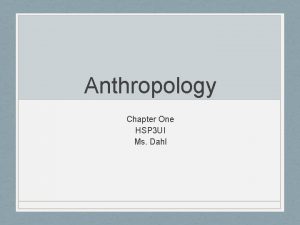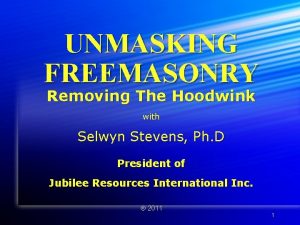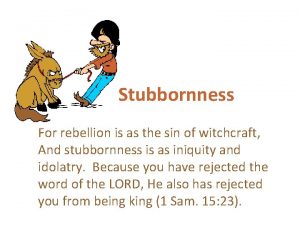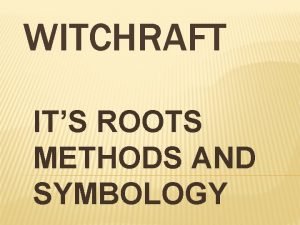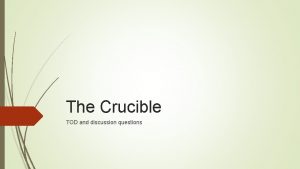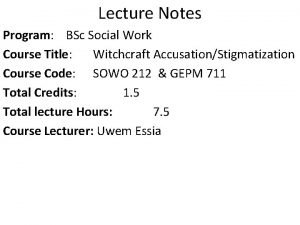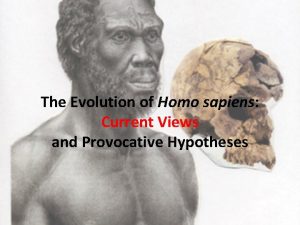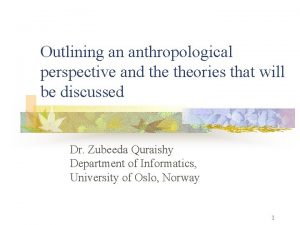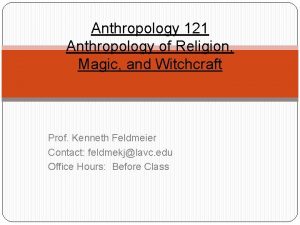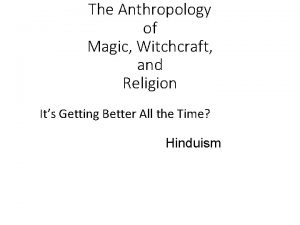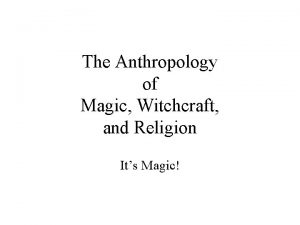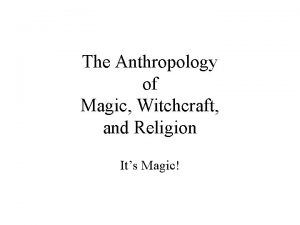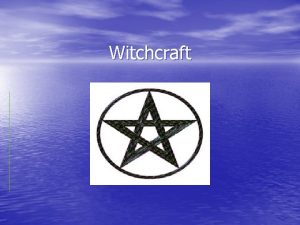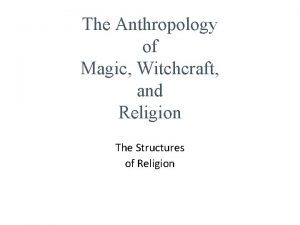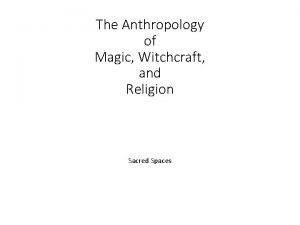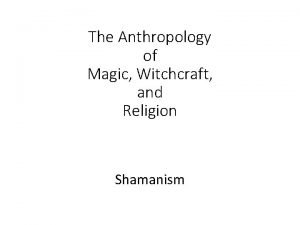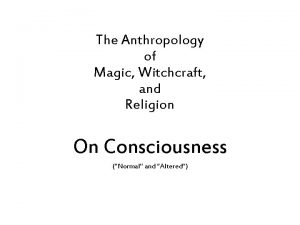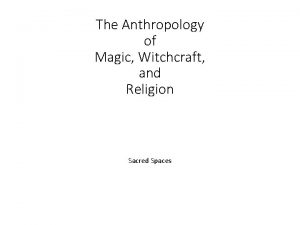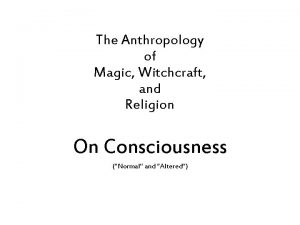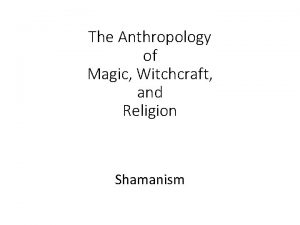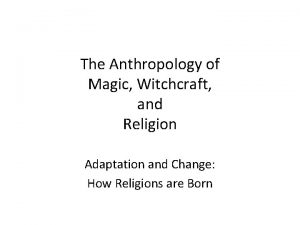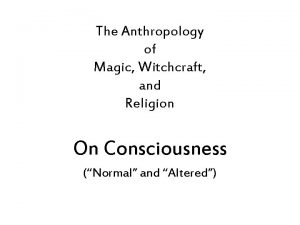The Anthropology of Magic Witchcraft and Religion Its



















- Slides: 19

The Anthropology of Magic, Witchcraft, and Religion It’s Getting Better All the Time

The Hindu Trimurthi

Central Concepts of Hinduism (substantive beliefs) • dharma – “duty”, “what you must do” • karma – a universal law of cause and effect all beings are born and reborn in positions that are at least partially determined by the results of their past actions

Central Concepts of Hinduism (substantive beliefs) • māyā – etymologically related to “measure” (root mā – “to measure, lay out, produce, create, display”) māyā is existence

Central Concepts of Hinduism (pantheon) • Brahman – a term used to refer to the one, indivisible, ultimate reality, of which māyā is the manifestation • Ātman – the manifestation of Brahman within the individual (approximates the English term “soul”)

Central Concepts of Hinduism (substantive beliefs) The aim of Indian thought is to learn that māyā exists and to cut through its webs of deception. In doing so, a person attains a reality which truly is reality: moksha – the liberation that results when a person understands the nature of the cycle of birth, death, and rebirth

In Hinduism unreality = all that is everchanging, transitory, elusive, and ever-returning reality = that which is changeless, imperishable, steadfast, and eternal That which cannot be comprehended by mind but by which the mind is comprehended – know that alone to be supreme being and not this or that god whom people ordinarily worship Kenopanishad – P. 1. 5 (ca. 600 B. C. E. )

What drives the cycle of birth, death, and rebirth? • ignorance • desire • attachment The Wheel of Life (Contemporary Tibetan Thangka)

Hinduism • a cyclical view of the world • cycles embedded in cycles • each world cycle has four world ages (yuga) v krita v treta v dvapara v kali

krita yuga (the “four-quartered” yuga ) • dharma stands on four legs, like the sacred cow • all beings follow their dharma of their own accord, all are virtuous • lasts for 1, 728, 000 years

treta yuga (the “three-quartered” yuga ) • the power of dharma stands on three legs • order is loosing ground • the observance of duty is no longer automatic, but must be learned • lasts for 1, 296, 000 years

dvapara yuga (the “two-quartered” yuga ) • dharma stands on two legs • a dangerous balance between perfection and imperfection, dark and light • knowledge of the divine is increasingly lost • true spirituality is disappearing, and can only be attained through fasting, vows, devotion, etc. • lasts for 864, 000 years

kali yuga (the “one-quartered” yuga ) • only ¼ of the original dharma is being observed • egotism, blind and reckless qualities prevail • humans and the world of humans are at their worst • lasts for 432, 000 years

kali yuga • began on Friday, February 18, 3102 B. C. E. • over 427, 000 years remain in the current yuga

maha yuga (the “great” yuga ) krita yuga 1, 728, 000 years treta yuga 1, 296, 000 years dvapara yuga kali yuga maha yuga 864, 000 years 432, 000 years _______ 4, 320, 000 years

Cycles of Existence • 1 maha yuga = 4, 320, 000 years • 1 kalpa (day of Brahma) = 1000 maga yuga = 4, 320, 000 years • each kalpa consists of 14 manvantaras (intervals of Manu), each of which ends in a great flood • we are currently in the 7 th manvantara of the present day of Brahma

Cycles of Existence • at the dawn of each kalpa, Brahma reemerges from a lotus which grows from the navel of Vishnu • at night, Brahma and all within him disappear for a period as long as one Brahma day

Cycles of Existence • after 100 years of Brahma days and nights, all is dissolved. • The three visible worlds (earth, heaven, and the space between) disappear, as do all the spheres of being • all is reabsorbed into the divine primeval substance

Cycles of Existence • this state lasts as long as one life of Brahma (a century of Brahma) • = 311, 040, 000, 000 years
 Hufflepuff first year timetable
Hufflepuff first year timetable Anthropology and its branches
Anthropology and its branches Western religion vs eastern religion
Western religion vs eastern religion Hoodwink freemasonry
Hoodwink freemasonry Disobedience is like the sin of witchcraft
Disobedience is like the sin of witchcraft No witchcraft for sale conflict
No witchcraft for sale conflict Prayers against the python spirit
Prayers against the python spirit Elisha prayer points for financial breakthrough
Elisha prayer points for financial breakthrough What kind of government does salem have in the crucible?
What kind of government does salem have in the crucible? Witchcraft symbology
Witchcraft symbology American academy of witchcraft arts
American academy of witchcraft arts Why is thomas putnam willing to speak of witchcraft?
Why is thomas putnam willing to speak of witchcraft? No witchcraft for sale
No witchcraft for sale There is either obedience or the church
There is either obedience or the church Bsc witchcraft
Bsc witchcraft No witchcraft for sale summary
No witchcraft for sale summary The bright filled paperweight
The bright filled paperweight Its halloween its halloween the moon is full and bright
Its halloween its halloween the moon is full and bright Lumpers and splitters anthropology
Lumpers and splitters anthropology Examples of anthropology perspective
Examples of anthropology perspective

